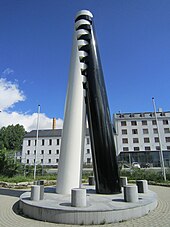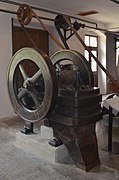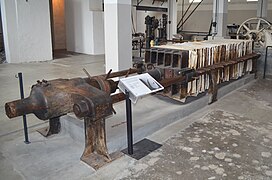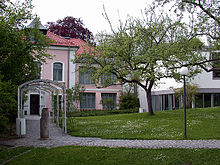Porzellanikon
The Porzellanikon is a museum complex that deals with the production of porcelain and ceramics in Selb and Hohenberg an der Eger in the district of Wunsiedel i. Fichtelgebirge ( Upper Franconia ) busy. It emerged from the merger of the Porzellanwelt Selb (with the European Industrial Museum for Porcelain, the European Museum for Technical Ceramics and the Rosenthal Museum) and the German Porcelain Museum in Hohenberg an der Eger.
Since 2012 the Porzellanikon has been included in the European Ceramic Route as a member of the “Urban Network for Innovation in Ceramics” .
Location Selb
The city of Selb is considered the center of the German porcelain industry. The porcelain manufacturers based in Selb and the surrounding area are market leaders in the field of tableware. The museum complex of the Porzellanikon Selb consists of three museums. The European Industrial Museum for Porcelain shows the factory production of porcelain . The European Museum of Technical Ceramics deals with the use of ceramics in the fields of medicine, electrical engineering and space travel. The Rosenthal Museum documents the product and design history of Rosenthal AG , a manufacturer of porcelain and other household goods.
European Industrial Museum for Porcelain
The European Industrial Museum for Porcelain is located on the former factory premises of Rosenthal AG in Selb-Plößberg (Bavaria). The factory, which was founded in 1866, is now a recognized industrial monument . The museum shows - for example at workplaces that are true to the original - the development of porcelain production in a factory and its conditions from the beginnings to the present day. It is an anchor point on the European Route of Industrial Heritage (ERIH).
It shows how porcelain tableware is and was made. Screens show the inner workings of complex machines and thus make their functionality comprehensible. The use of special software enables the experimental design of three-dimensional porcelain objects. Further questions can be clarified via touchscreen applications. The museum also takes up socio-historical issues.
European Museum of Technical Ceramics
The European Museum for Technical Ceramics was opened on October 10, 2005 as part of the Porzellanikon Selb. It is the first museum in Europe dedicated to high-performance ceramics. Numerous manufacturers of technical ceramics as well as the Association of the Ceramic Industry (Selb) participated in its creation.
Technical ceramics were first used in the form of dentures during the French Revolution. Under Frederick the Great, the acid resistance of porcelain was used for laboratory and pharmacy dishes. Finally, in 1849, the first ceramic bell insulator was used on the telegraph line between Frankfurt and Berlin. In 1891, porcelain insulators were presented for the first time at the electrical engineering exhibition in Frankfurt . The further development of the technology brought a multitude of other possible uses for technical ceramics.
Today, technical ceramics can also be found in everyday objects such as lighters, cell phones, espresso machines and cars, as the material is heat-resistant, durable and hard. Ceramic blades cut diamonds, for example.
Rosenthal Museum
With the Rosenthal Museum, Rosenthal AG returned to its old factory premises on the occasion of its 125th anniversary. The museum is housed in the old distillery of the former factory. The building, originally built in 1889, burned down to the outer walls in 1982. Its reconstruction took into account the idea of an “open space concept”. The front one of the three round ovens originally standing one behind the other was completely renovated.
The museum shows the history of the company and its products in various themed islands, which began on August 30, 1879 in Schloss Erkersreuth with the porcelain painting by Philipp Rosenthal. In 1917 Rosenthal acquired the porcelain factory founded by Jacob Zeidler in Selb-Plößberg in 1866. The company used the factory facilities until it relocated its production to Rotbühl in 1969.
As a manufacturer of living spaces and a lifestyle provider, Rosenthal relied early on in combining art, architecture, design, porcelain and other materials. Building on the designs of product designers working for Rosenthal such as Walter Gropius , Elsa Fischer-Treyden or Bjørn Wiinblad , the company was able to win over internationally renowned artists such as Salvador Dalí , Friedensreich Hundertwasser and Niki de Saint Phalle for a collaboration.
In 2009, the Rosenthal collection of the insolvent porcelain manufacturer Rosenthal was bought by the Upper Franconian Foundation, including originals by Salvador Dalí and Andy Warhol . The foundation left the fund to the porcelain museum.
Location Hohenberg an der Eger
The German Porcelain Museum was opened in Hohenberg an der Eger in 1982. The complex had previously served as the director's villa for the family company Carolus Magnus Hutschenreuther . By founding the first porcelain factory in northeast Bavaria in 1814, Hutschenreuther laid the foundation stone in Hohenberg for the region to quickly develop into the center of the German porcelain industry. In 1995 the historic house was expanded to include a modern extension made of glass and steel to 2000 m². Today the museum shows around 12,000 exhibits, more than 150,000 parts are in the depot.
The permanent exhibition shows porcelain products from China as well as all types of porcelain that was produced in the German-speaking area, both valuable one-offs for aristocrats and industrial products. The tour is arranged chronologically . In each room the visitor is shown features of an art era . In front of the buildings is the former factory owner's garden with apple trees and rose arbors.
Exhibitions
In 2016 the exhibition Rosenthal - a Myth was in the museum at both locations . Watch two men write history . The permanent exhibition of the permanent collection "White Oasis & Highlights" shows works by Helmut Drexler .
Individual evidence
- ↑ City network for ceramic innovation
- ^ Art belongs on the table in FAZ from September 26, 2016, page 12
Web links
- Internet presence of the Porzellanikon Selb museum complex
- Rosenthal Museum in the European Industrial Museum for Porcelain
- German Porcelain Museum in Hohenberg an der Eger
Coordinates: 50 ° 10 ′ 10.2 ″ N , 12 ° 7 ′ 43.3 ″ E






